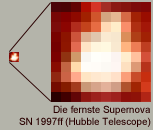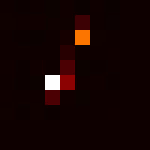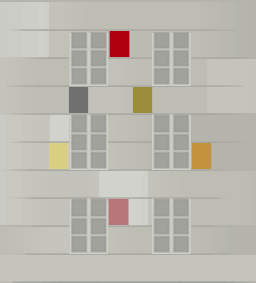
Tim Otto Roth
"I see what I see not"New accesses to the spheres of visibility and invisibility were presented at the art façade by Tim Otto Roth during the last cycle in winter 2003/04. He changed the space into an interface between art and science. Extreme views from astronomy and particle physics created a visual trip to the pixeling edges of the universe but as well to the edges of technical perception. "A beautiful game about the autonomous extension of constructive art by the means of physics" (Süddeutsche Zeitung).
Are 10 by 10 pixels an image?
 For Tim Otto Roth the art facade represented a formal challenge. The basic question was whether it would be possible to show something that still could be called a picture, on an area, which consists solely of 10*10 picture elements. He decided to explore the images of astronomy and elementary particle physics. In these advanced disciplines already few pixels detected by the image sensors can refer to an astronomical object or a subatomic particle.
For Tim Otto Roth the art facade represented a formal challenge. The basic question was whether it would be possible to show something that still could be called a picture, on an area, which consists solely of 10*10 picture elements. He decided to explore the images of astronomy and elementary particle physics. In these advanced disciplines already few pixels detected by the image sensors can refer to an astronomical object or a subatomic particle.
Cosmological matrix
So the the art facade changed into a cosmic matrix showing the most advanced results from vision machines of astronomy and elementary particle physics. This light game on the art facade became so a walk on the retinas of the extreme sciences, that investigate the most distant and next boundaries of the cosmos.
Trip to the edges of imaging appartuses
Roth goes herewith on cloth contact with receptions out of the different spectra of terrestrial super telescopes or satellite based detection devices. In the subatomic area he grasped on current pictures of the large particle accelerators. Zooming in the images on the pixel level the edges of visibility of the contemporary imaging apparatuses are revealed.

Between visibility and visibility
This pixel trip becomes a double game between visibility and invisibility. The simple-minded eye sees in the picture like here in an image made by the Hubble Space Telescope of the most distant supernova except a couple of red and white pixels, nothing. Without the corresponding background knowledge, the phenomena remain invisible. For the scientist such a navigation always implements a boundary gear between machine produced visibility and invisibility of the phenomena.
Close and distant
The artistic intervention exists among other things therein that pictures from the opposed ending of the cosmic scale are presented together at the art facade. The spectators perception is challenged by a pixel shower, that can’t be distinguished formally hardly in closely and distant.
Watch a clip about the recent cycle: 8,0 MB, QT mov

What you see (here)  Particle crash Particle crash
In March the art façade changed into a window to the experiments of the Tevatron at the Fermilabs/USA. Protones and antiprotones collide there at speed of 99,99996 percent of the speed of light . ... more
 Cosmisc blush Cosmisc blush
The colour trend of the universe has changed over the billions of years. Before a bluish shining was dominant in the universe . If the colour has shifted to turquoise, to beige or to a reddish tone is not only a discussion among astronomers but also among colour physiologists. ... more
 Christmas star Christmas star
Neither a comet nor a supernova was the star of the wise men. ... more

 Cosmic fatamorgana Cosmic fatamorgana
Massy objects can have an effect of a lense. The hotest star region was discovered by such a gravitational lense... more

 Discovery of the "heavy light" Discovery of the "heavy light"
A milestone in elementary physic was the discovery of the W- und Z-particle. The physicists at CERN created conditions existing just 10 microsecondes after the big-bang. ... more (external link)

 Lockman-Hole Lockman-Hole
This image of ROSAT shows a detail from the Lockman-Hole. The exposure time was about 53 hours. ... more

 Crab Pulsar NP 0532 Crab Pulsar NP 0532
The pulsing neutron star in the crab nebula is a rest of supernova dated in china about the year 1054. The supernova should have been visible for weeks or even months with the naked eye. ... more
 The sharpest look up to the sky - the VLTI The sharpest look up to the sky - the VLTI
Achernar
The "Very Large Telescope Interferometer" will be able in the future to superpose the pictures of up to 4 telescopes. This overlay of the light beams of several telescopes creates a type of virtual super telescope. ... more
 Echo of the big bang - the cosmic background radiation Echo of the big bang - the cosmic background radiation
Wilkinson Microwave Anisotropy Probe
The images of the cosmic background radiation made by the Wilkinson Microwave Anisotropy throw a look back 379,000 years after the big bang. ... more
 Look in subatomac spheres Look in subatomac spheres
Star Collider, Brookhaven National Laboratory
The flights paths of the particle shower of one the first full energy collision of gold ions, received through the STAR collider on Long Island. ... more
 Exploring the limits Exploring the limits
Doublstar GJ263 - one of the first images made by adaptive optics at Cerro Paranal. ... more

 Deep Fields Deep Fields
The "Deep Fields" are longtime exposures from far distant sky regions. ... more

 Redshift 6.4 Quasar - one of the oldes images Redshift 6.4 Quasar - one of the oldes images
The images from the Sloan Digital Survey (SDS) show the presently most distant quasar that was discovered ever (October 2003). ... more

 "Hypernova" "Hypernova"
A very young discovery are the so called "Gamma Ray Bursts". ... more
|


